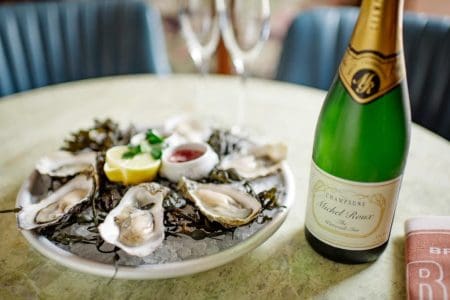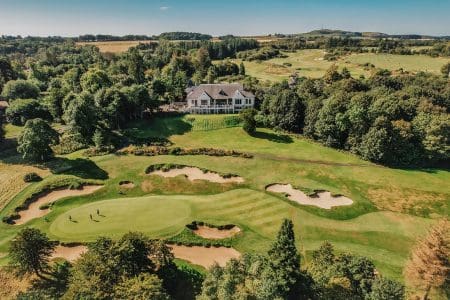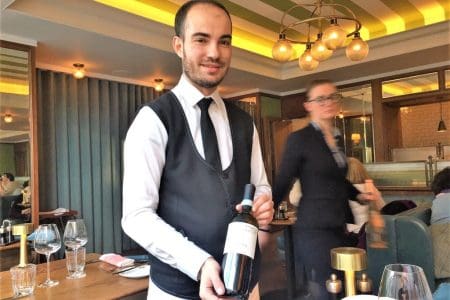Roger Hermiston and Eileen Wise visit Royal Troon Scotland on the final day of The Open Championship.
The seaside town of Troon in Ayrshire, on Scotland’s spectacular west coast, would be a delightful place to visit at any time. It has a pretty harbour that serves as a fishing and ferry port, and a modern marina which attracts serious yachtsmen. The beach is a long, sweeping stretch of sand with a lively esplanade and superb views over the Firth of Clyde to the nearby wildlife haven of the Isle of Arran, where golden eagles soar and seals and otters frolic at the water’s edge.
But every seven years or so the sporting world’s attention focuses on Troon’s greatest modern asset – golf. There are seven excellent courses in and around the town, but it is Royal Troon that has, over the past century, established itself as one of the leading venues for arguably the greatest tournament in the professional golf calendar – The Open Championship.
Royal Troon Golf Club
Troon Golf Club (as it was then) was founded in 1878 when golf fever was at its height in Scotland, but it took another 45 years before it was deemed capable of hosting the sport’s premier tournament.
Nowadays this magnificent links course is regarded as one of the toughest tests a golfer can face. The 18 holes are said to mirror Dante’s Divine Comedy – a challenge, or an ordeal, in three acts. The first six, relatively benign holes, are Heaven. The next six, increasingly demanding, are Purgatory. And the final brutal six, especially when the wind blows, are Hell. This is a golf course that demands respect – ‘it’s not about what you can do, but what you mustn’t do’ is the watchword.
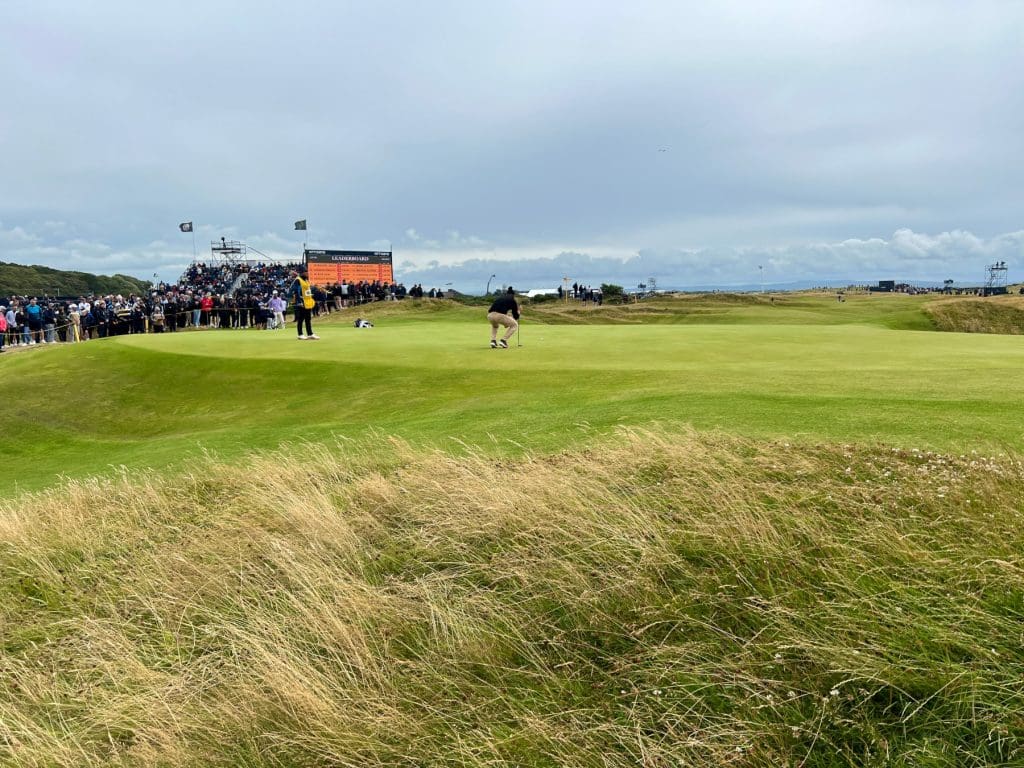
We were excited to come to Royal Troon in July (it was granted its ‘Royal’ designation in 1978 on the occasion of its centenary) to watch the final day of its tenth hosting of The Open. We were there courtesy of The Experience Golf, a sporting travel company that provides unparalleled access and adventure at some of the world’s greatest golf venues.
We had signed up for a week-long tour with The Experience Golf which, after our prized admission to watch the conclusion of The Open, would be followed by a journey over to the east coast to the Home of Golf, St Andrews. There Roger would have the golden opportunity of playing four fantastic courses (including the iconic Old Course), and from where Roger and Eileen could also explore the fascinating region of East Neuk (more of all that in Part 2 of A Scottish Odyssey).
Day at The Open Championship
We flew from Stansted to Glasgow on Saturday afternoon, where we quickly settled into our comfortable first base, the Hilton Hotel on William Street, conveniently situated on the edge of the city centre. We had a well-appointed room with a panoramic view out over this gritty, yet elegant city. It was but a short walk for dinner to the atmospheric Italian restaurant, Piccolo Mondo, where we enjoyed excellent pasta dishes with a Tuscan twist.
At 10 o’clock the following morning we hopped onto The Experience coach for the forty-minute journey to Royal Troon golf club. On arrival what impressed us firstly was the slick organisation of such a big event – the carefully laid out parking areas for cars and coaches, and then the well signposted route for walking to the venue, across fields and over an old railway bridge.
Quickly through the expertly-marshalled entrance gates, we found ourselves in a temporary Spectator Village, which included numerous food and drink outlets, a ‘Golfzone’ and ‘Swingzone’ where you could have fun in testing your distinctly amateur skills, and an enormous marquee housing ‘The Shop’, where golf clothing brands had set up their stalls and where plenty of memorabilia was on sale. The queues to get in here were consistently long so we left it until mid-afternoon before making our entrance.
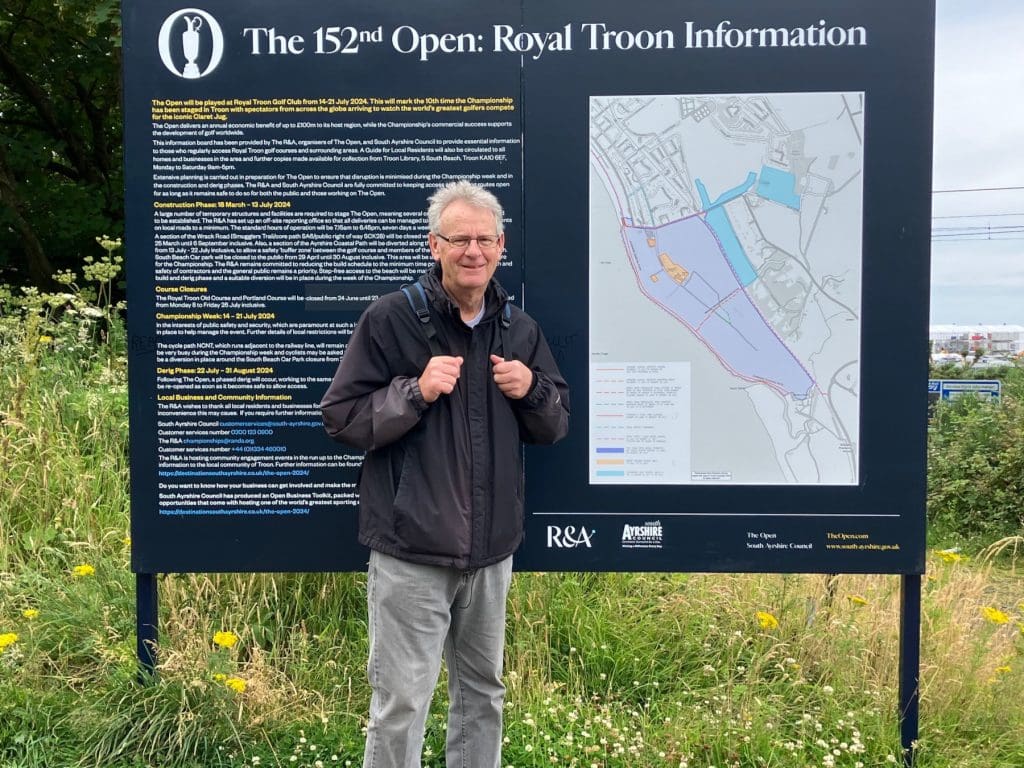
Next to The Shop, with a big open area in front of it for both seated and sitting spectators, was the NTT Data Wall, a huge 20-metre-wide LED screen transmitting live action out on the course, and providing remarkably detailed data about the speed, length and trajectory of the golfers’ shots.
It was a great facility, the central hub of activity, and would prove invaluable later in the day when it became impossible to get near to the action on the course. But we had come to get up as close and personal to the world’s golfing greats as we could, so we set out to explore how best to walk the course to enable us to do just that.
A helpful map showed us the Red Route, which would plot us round the entire eighteen holes, over six kilometres in total or 10,000 steps. But we quickly discovered that there was greater value in lingering at certain areas of the course where the tees and the greens of a cluster of holes were in close proximity, and where there was grandstand seating (13th, 14th and 15th, from memory).
Elsewhere we stopped briefly to watch the mistakes flow at Royal Troon’s most famous hole – the eighth, named the Postage Stamp after its narrow green, guarded by five devilish bunkers (one named Coffin). Located among choppy dunes, and played from a scenic, elevated tee, it is only 123 yards long, but has struck fear into the best of golfers over the years. German amateur Herman Tissies racked up a 15 here in the 1950 Open, while the victory charges of Greg Norman (1989) and Tiger Woods (1997) were halted due to fatal mistakes at this little hole.
Talking of Tiger, it had been Roger’s plan (no doubt like many thousands of others) to follow the great man on the final round. It’s one thing watching your sporting heroes on the TV screen, every detail of every shot perfectly captured for you. But it’s another to follow their journey at ground level, experience their aura and feel the atmosphere out on the course.
On the Trail of Joe Dean
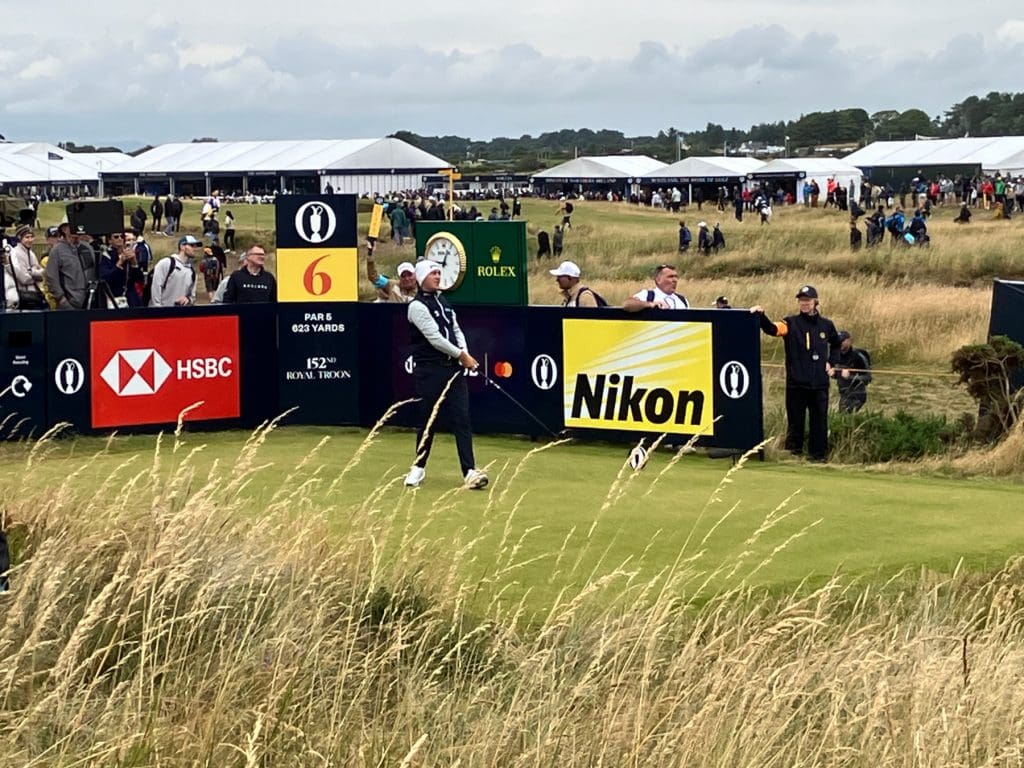
Sadly Tiger failed to make the ‘cut’ for the weekend, his lack of regular tournament play these days catching up with him. With Rory McIlroy also eliminated, we moved to Plan C and decided to spend time hard on the heels of Joe Dean, a 30-year-old, unknown (outside of the golfing fraternity) British professional from Sheffield.
This was the romantic story of The Royal Troon Open, featured in media as diverse as Radio 4’s Today programme and The New York Post. That’s because of the other job Joe has undertaken to supplement his earnings away from the professional golf circuit – that of a delivery driver for the supermarket chain Morrisons.
The humdrum nature of this secondary career juxtaposed with his struggles in the supposed glamorous world of the golfing pro caught the public’s imagination. There was sympathy too, for Joe’s fear of flying, which hampered his participation in European and World tour events – an affliction only recently partly assuaged by a course of hypnotherapy.
The fact that he is a modest, likeable man added to the attraction. The reality was, though, that – after years of struggle – Joe entered the Open Championship in the form of his life, after strong finishes in tournaments in Kenya and Amsterdam which had earned him decent paydays. But how would he fare in the biggest tournament of them all?
The answer was very well indeed. He comfortably made the cut with rounds of 69 and 77, followed by par 71 in the third. In this final round he was paired with Ewen Ferguson, and the Anglo-Scottish duo seemed to enjoy each other’s company and consequently both flourished.
Joe is a rarity among golfing pros in that he sees no need for extensive practice before he starts his big tournament rounds. A few chips and putts are all that are necessary, he says, to conserve his energy – thereby endearing himself to the thousands of Saturday golfers who have exactly the same routine!
Practice or not, his performance in the last round was very steady. Distinctive in a big blue and white bobble hat to ward off a cold wind, we watched him swing strongly out of the thick rough, and audaciously turn his putter round to play left-handed when his ball was on the very edge of a deep bunker he couldn’t get down into for a stance.
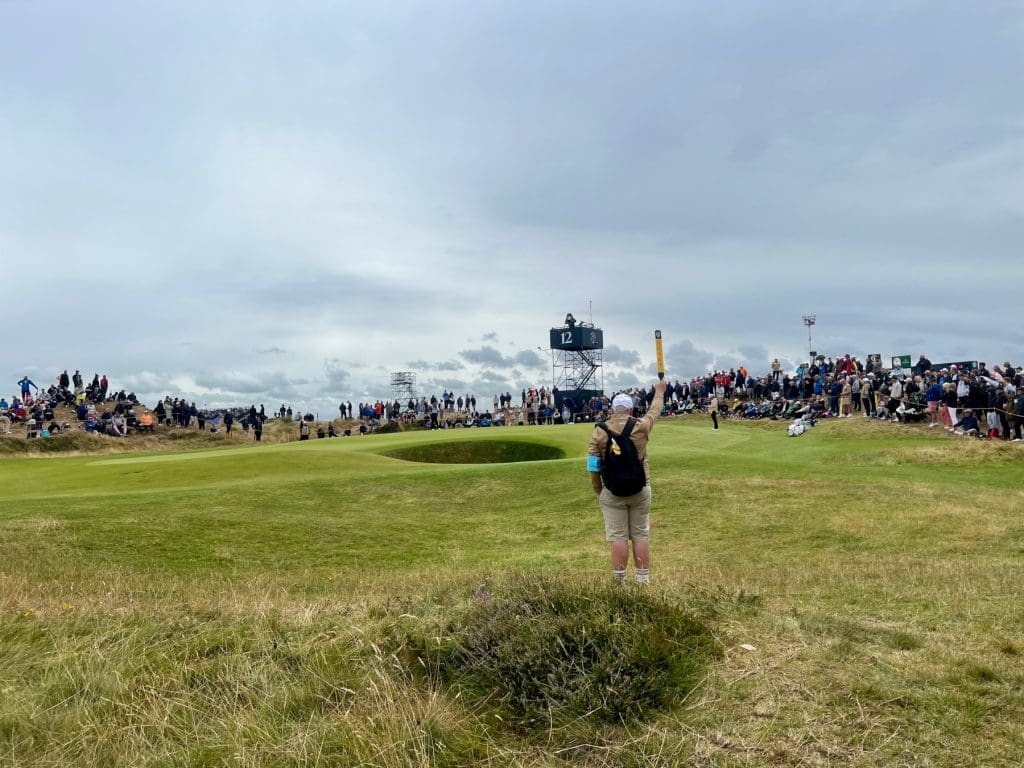
There were a couple of hiccups with bogeys on the 13th and 14th holes, but Joe recovered to birdie the par-5 16th and comfortably parred the final three testing holes. He would finish a highly creditable 25th, meriting a purse of $137,600 – not bad for this ‘journeyman’ pro.
As the afternoon wore on and the battle for the main prize intensified between Britain’s Justin Rose and America’s Xander Schauffele, huge roars would suddenly pop up from distant parts of the course as one or the other struck birdies.
By the time these leaders approached the 16th hole, there were no seats left in any of the grandstands, and the crowds were four or five deep along the fairway. So we headed back to the big screen to watch Schauffele finish superbly to win the Claret Jug – and a second ‘major’ tournament in succession.
Once back on The Experience Golf coach we were able to make a swift and smooth exit out of Troon. We had had an experience to linger long in the memory, as good as we might have hoped for at such a major sporting event. Next stop St Andrews.
